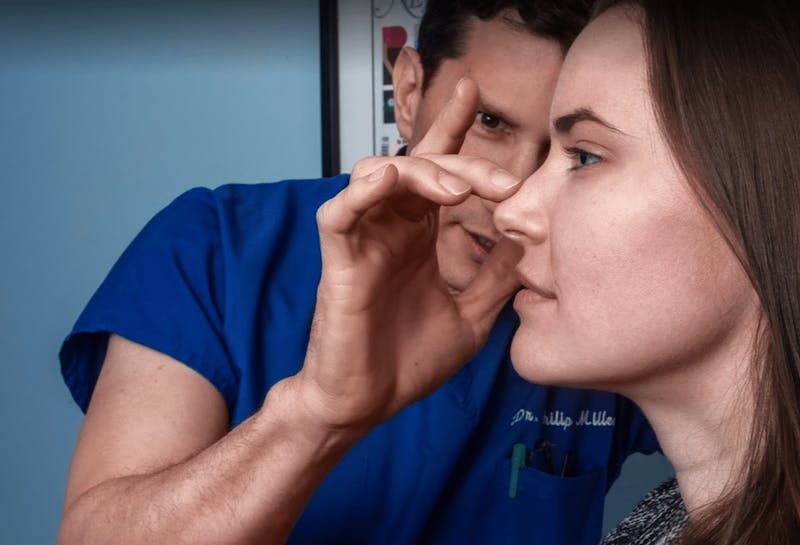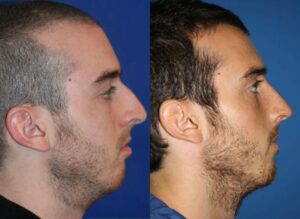
Planning for Your Rhinoplasty: Open vs. Closed Technique

September 28, 2021
If you’re unhappy with the appearance of your nose, you’re not alone. According to the American Society of Plastic Surgeons, rhinoplasties, or nose jobs, are the most common facial plastic surgery procedures in the U.S. Many people feel that their nose is too prominent and detracts from other facial features, while others long for more definition of their nasal tip.
No matter your concern, double board-certified facial plastic surgeon, Philip J. Miller, MD, FACS, in New York City has the artistic skill and experience to reshape or reconstruct your nose for enhanced facial symmetry. His goal is to bring balance to your features by evaluating the prominence of your cheekbones and jawline, the width of your eyes, and even the texture of your skin before making recommendations regarding your nose.
The next step is determining whether you’re a better candidate for open or closed rhinoplasty. While both procedures can achieve exceptional results, each has its own advantages and drawbacks to consider during your consultation.
Open Rhinoplasty
An open rhinoplasty provides enhanced visibility when maneuvering through the bone, cartilage, and tissue that make up the nose. When performing this highly common type of rhinoplasty, Dr. Miller can reshape the nose and repair damage without jeopardizing its structural support.
Dr. Miller typically recommends open rhinoplasties for patients with complex structural concerns, such as:
- A severely crooked nose
- Nasal trauma or deformities
- An asymmetrical tip
- A large nasal tip
- A large dorsal hump (bump on the nasal bridge)
An open technique is also best for revision rhinoplasty. If you’ve had rhinoplasty in the past and are unhappy with the results, Dr. Miller can perform open rhinoplasty to address your concerns.
Open Rhinoplasty Pros / ConsChoosing an open rhinoplasty offers many advantages if you want to reshape your nasal structure, particularly if your case is complex. However, there are certain considerations to take into account before making your choice.

Pros: Improved Precision
Opening the columella allows Dr. Miller to see the internal structures of your nose. As a result, he can correct complex nasal deformities with precision and accuracy. Clear visibility also allows him to preserve as much of your tissue, cartilage, and bone as possible because he can reshape rather than remove it.
Pros: Enhanced Structural Support
By confining all incisions to the outside of the nose, Dr. Miller can maintain its structural stability. He’s able to create dramatic results without disrupting much of the surrounding bone, cartilage, and tissue.
Cons: Scarring
Since an open rhinoplasty requires an external incision, you may have minor scarring after the procedure. Fortunately, the Z-shaped incision is very small, so the scarring should fade with time. Furthermore, Dr. Miller carefully takes your skin and facial structure into consideration before making the incision. This step ensures that the scar is barely visible as it is between the nostrils at the base of the nose.
Cons: Longer Recovery
An open rhinoplasty is inherently more invasive than a closed rhinoplasty, so it’s no surprise that the recovery process is slightly longer. Many patients find that rhinoplasty is less painful than expected, but swelling and discomfort are common side effects of the procedure. You may also experience congestion for the first few days. Most patients can resume their normal activities within 7-14 days. To accelerate your recovery, keep the incision site clean, avoid strenuous exercise, and refrain from tobacco use.
Closed RhinoplastyAlso called an endonasal rhinoplasty, a closed rhinoplasty is an internal procedure in which all incisions are confined to the inside of the nostrils. Patients concerned about visible scarring need not worry with a closed rhinoplasty. During the procedure, Dr. Miller carefully lifts the underlying bone, cartilage, and tissue through the nostrils, so you won’t be able to see any scarring.
Closed Rhinoplasty Pros / ConsA closed rhinoplasty is especially appealing for those who want to make minor modifications to their nose. It’s also ideal if you have breathing problems, such as chronic sinusitis. As a more conservative type of rhinoplasty, however, this technique isn’t right for everyone.

Pros: No Visible Scarring
The primary benefit of a closed rhinoplasty is that there’s no external evidence of the procedure. All stitches are located inside the nose, so you may feel more comfortable resuming your normal activities sooner than you might after an open rhinoplasty.
Pros: Shorter Recovery Time
With no external incisions, the skin between the tip and bridge of the nose remains intact. This means blood circulation functions normally and fluid can drain rather than accumulate. As a result, most patients start to recover within one week. However, rigorous exercise, smoking, and blowing your nose can hinder your recovery.
Pros: Subtle Results
Closed rhinoplasties typically address less complex nasal concerns than open procedures. If you have a dorsal hump, wide nasal bridge, or enlarged nasal tip, a closed rhinoplasty can deliver subtle results with little impact to the surrounding tissue.
Cons: Low Visibility
Since a closed rhinoplasty is performed through the nostrils, visibility is limited during the procedure. An endoscope can provide a clearer view of the internal structures, but an open rhinoplasty will always have fewer obstructions.
Cons: Limited Modifications
With low visibility and limited access, a closed rhinoplasty is not the best choice for complex nasal modifications that require extreme precision. Instead, the closed technique is ideal for minor adjustments to the nasal tip and bridge.
Which one Should You Choose?The best type of rhinoplasty for you depends entirely on the concerns you want to address. Neither technique is necessarily better than the other. To ensure you achieve the best results possible, Dr. Miller offers a proprietary consultation process called NatraLook. During your NatraLook consultation, he evaluates your nose and facial features while listening to your concerns and goals. This process establishes a collaborative environment in which you and Dr. Miller can create a unified vision for your results and the most natural outcome possible.
Contact Our Plastic Surgery Clinic Today
To learn more about the different types of rhinoplasty procedures Dr. Miller performs and find out which technique is best for you, contact our New York City plastic surgery clinic today.

Focusing exclusively on the face for more than two decades, double-board certified facial plastic surgeon Dr. Philip Miller blends art and science with innovation and skill to provide thousands of patients with impeccable results. He is known for pioneering the NatraLook methodology for rhinoplasty, facelifts, neck lifts, and other cosmetic procedures for the face.

